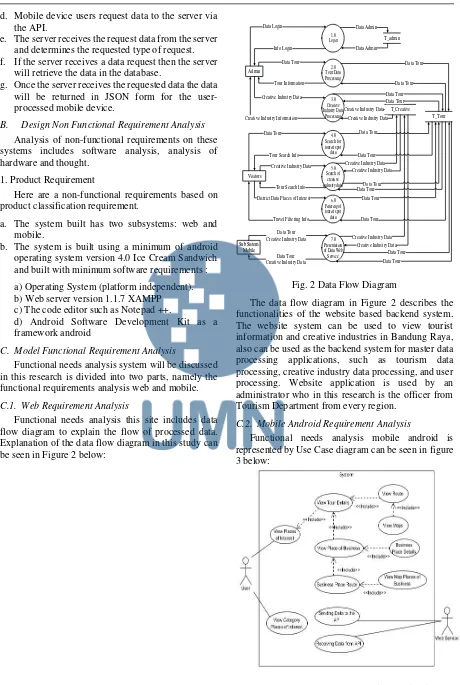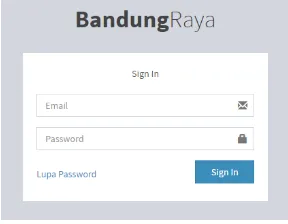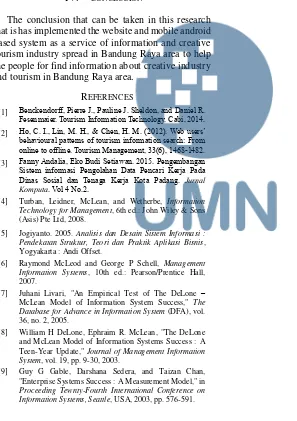IJNMT, Vol. IV, No. 2 | December 2017 120
ISSN 2354-0082
Information of Tourism and Creative Industry
Using Mobile Application Technology
Deden A Wahab
1, Eko Budi Setiawan
2, Rahma Wahdiniwaty
3 1,3Program Studi Magister Manajemen, Universitas Komputer Indonesia2Program Studi Teknik Informatika, Universitas Komputer Indonesia
[email protected] [email protected] Received on October 22nd, 2017 Accepted on December 20th, 2017
Abstract—Creative industries and tourism is one sector that is easiest to improve the condition of the economy of a region. This study discusses the information distribution service usage model of mobile application technology using Location Based Service (LBS) and Global Positioning System (GPS) in the development of creative industries through integration with products of tourist destinations. By using the technology of location-based services and global positioning system that will be developed and implemented on the application of geographic information systems and web-based mobile android, then the those creative industries would be material and guidance in utilizing information technology as a means to promote the business of creative industries it has to be more effective and efficient.
Index Term—Geographic Information Systems, Creative Industries, Mobile Android, GPS, LBS.
I. INTRODUCTION
The development of technology has grown very rapidly, especially information and communication technology. With the development of information and communication technology, the use of smartphones in the world today is growing very rapidly. This is due to the high will communication needs to obtain information that can be fulfilled with the smartphone. In the society of creative industries and tourism, their business will not be separated from the information technology that is used when the process of sale transaction [1].
Bandung Raya area consisting of Bandung City, Bandung Regency, West Bandung Regency and Cimahi City, from the past until now has been known by the public in Indonesia as a city of tourist destinations and producers of creative industries.
Currently near the tourist destination, also there are also places that provide souvenirs. This is because every tourist who has been traveling, also most certainly buy souvenirs. Lots of results from the creative industry into a souvenir product. Usually for the creative industry products contained in the tourist location of Bandung Raya area is produced by local
communities or creative industrial centers of Bandung Raya region itself.
Most of the tourists who visit tourist sites, not knowing some of the products of creative industry businesses are also sold well it was right where the sights, or are located close to the tourist sites [2]. That is because the main goal is still a destination tourist destinations, not creative industries. In addition, the lack of information that is delivered to the tourists linked several creative industries can also be found and obtained at the location of tourist attractions, means that the creative industry businesses are still based on the arrival of tourists to the location of tourist destination.
At this time almost every smartphone is equipped with features Global Positioning System (GPS) sensor. The function of that GPS itself is a system where it is useful to determine the position of a location. With this feature, many people use it both to know the route of the road as well as find an alternative way or the latest road conditions whether stuck or not. Many are also using GPS to find information about tourism or creative industries in certain cities, especially in Bandung Raya area.
This research will create an application web and mobile android where the application is used to facilitate the tourists to know the good information about the object of tourism in Bandung Raya area along with the creative industries located adjacent to the tourist attraction. In addition, this research can also help the tourists and search by the results of the creative industry in terms of searching the desired location using android smartphone and web-based.
121 IJNMT, Vol. IV, No. 2 | December 2017
ISSN 2354-0082
II. LITERATURE REVIEW
A. Creative Industry
Based on the trade department of the Republic of Indonesia, the creative industry is an industry that is derived from the utilization of creativity, skill, and talent of individuals to create wealth and jobs through the creation and utilization of creativity and inventiveness of the individual.
The government of the Republic of Indonesia through the Ministry of Tourism and Creative Economy has identified the scope of the creative industry includes 15 sub-sectors. Sub-sectors, namely advertising, architecture, market art, crafts, design, fashion, video, film and photography, interactive games, music, performing arts, publishing and printing, computer services and software, broadcasting, research and development, and the last is culinary.
B. Systems Theory
According to research Fanny and Eko [3], there are two groups of approaches in defining the system. There is emphasis on the procedure and there is an emphasis on the component or element Turban [4], including: “The first opinion stressing the system components. "The system is a collection of elements that interact to achieve a certain goal". A second opinion on the procedure stressed system. "The system is a network of procedures that are interconnected, gathered together to perform an activity or to accomplish a particular goal."
C. Information Theory
Information is data that has been organized so that gives meaning and value to the recipient. Meanwhile, according to Jogiyanto [5], information is data that is processed into a form that is more useful and more meaningful for those who receive. It can be said that the data is the raw material, while the information is so material or material which is ready to use. Indicators that can be used to measure the quality of information is the relevance, timeliness and completeness [6], accurate [7], and understandability [8] [9] of the information produced.
D. System Design
The design of the system is a stage in building a system after the stage of system analysis and system development cycle. This stage defines the functional requirements and describes a system to be built. In designing a system can use a structured modeling using graphs or charts, or using the concept of object-oriented.
E. Location Based Service
Location Based Services (LBS) is an information service that can be deployed using mobile devices over the internet and mobile networks and utilize the ability of the locator on mobile devices. LBS works to utilize
the location of the device to provide information about the location using the Global Positioning System (GPS).
F. Global Positioning System (GPS)
Global Positioning System (GPS) is a navigation system or a satellite-based positioning. This system is designed to provide information on the position and time continuous throughout the world, regardless of time and weather. GPS positioning is described using X and Y coordinate values where the value longitude and latitude. This system is used to determine the position on the surface of the earth with the help of 24 satellites that transmit microwave signals to Earth.
GPS systems work is to transmit signals from GPS satellites to devices that may be present on a smartphone that already has a GPS feature. GPS requires transmission of three satellites to obtain two-dimensional information of latitude and longitude, and 4 satellites to three-dimensional (latitude, longitude, and altitude). Because GPS satellites rely on the work, so its use is recommended in the open. The use indoors at a place that hinder way satellite, the GPS will not work accurately and optimally. Location Based Service (LBS) is an information service that can accessing use mobile devices through the Internet.
III. RESULT AND DISCUSSION
A. Architecture Design Analysis Model
The analysis aims to identify the system architecture that will be built based on two subsystems web and mobile. The system architecture in this research can see in figure 1.
Fig 1. Overall Architecture Systems The explanation of fig 1 system architecture above, namely:
a. The web sub admin system requests data requests to the server via the internet network.
b. The server receives a request for data requests and retrieves data on request from the database. c. The server sends the requested data over the
IJNMT, Vol. IV, No. 2 | December 2017 122
ISSN 2354-0082
d. Mobile device users request data to the server via the API.
e. The server receives the request data from the server and determines the requested type of request. f. If the server receives a data request then the server
will retrieve the data in the database.
g. Once the server receives the requested data the data will be returned in JSON form for the user-processed mobile device.
B. Design Non Functional Requirement Analysis
Analysis of non-functional requirements on these systems includes software analysis, analysis of hardware and thought.
1. Product Requirement operating system version 4.0 Ice Cream Sandwich and built with minimum software requirements : a) Operating System (platform independent). b) Web server version 1.1.7 XAMPP c) The code editor such as Notepad ++.
d) Android Software Development Kit as a framework android
C. Model Functional Requirement Analysis
Functional needs analysis system will be discussed in this research is divided into two parts, namely the functional requirements analysis web and mobile.
C.1. Web Requirement Analysis
Functional needs analysis this site includes data flow diagram to explain the flow of processed data. Explanation of the data flow diagram in this study can be seen in Figure 2 below:
District Data Places of Interest
Travel Filtering Info Fig. 2 Data Flow Diagram
The data flow diagram in Figure 2 describes the functionalities of the website based backend system. The website system can be used to view tourist information and creative industries in Bandung Raya, also can be used as the backend system for master data processing applications, such as tourism data processing, creative industry data processing, and user processing. Website application is used by an administrator who in this research is the officer from Tourism Department from every region.
C.2. Mobile Android Requirement Analysis
Functional needs analysis mobile android is represented by Use Case diagram can be seen in figure 3 below:
123 IJNMT, Vol. IV, No. 2 | December 2017
ISSN 2354-0082
The actor's explanation of the use case diagram is that the user actor has the authority to use functionality at the user interface level, whereas the actor web service as the provider of the data source API and runs in the background. Android system users can only view the data only, cannot perform the process of data processing as can be done on the website.
As for the definition of a use case diagram in figure 3 above are shown in table 1.
TABLE I. Use Case Diagram No Use case Description
1 View Places of Interest
The system displays a list of tourist attractions and can be selected by the user. 2
View Category Places of Interest
The system displays categories of attractions. 3 View Tour
Details
The system displays details on selected sites users.
4 View Route
The system displays the service road to the tourist attractions of the user's location.
5 View Map
The system displays the map location of tourist attractions.
6 View Places of
Business See Business Sites 7 Business Place
Route
The system displays the detail businesses that have been users
8 Route Place of Business
The system displays the service road to the place of business of the user's location.
9
View Map Places of Business
The system displays a map of the business location. 10 Sending data to
the API
The system sends the data via the API web service 11 Receiving Data
from API
Receiving Data from API Web Service
D. System Implementation
A scenario from an explanation of system implementation in this research is divided into three parts, that is website implementation for the visitor, website implementation for administrator and implementation of android mobile for society.
D.1. Implementation of Website System For Visitors
Users as a public can open url address http://bandungraya.umkmbandung.com on the browser. The initial view of the main page of the website for the end can be seen in figure 4 below.
Fig 4. Main Website of Visitors
On the website, visitors can see other menus such as tourist attractions, creative industries and filtering information in accordance with the wishes. An example of the result of information filtering can be seen in figure 5.
Fig 5. Filtering Information
D.2. Website System Implementation For
Administrators
The website page for this administrator is used by an administrator who is an employee of the department of tourism or employees of the department of industry to perform data processing on the website. The discussion on the system page for administrators consists of login, admin data processing, tourism data processing, and creative industry data processing.
Before entering the administrator page, the system requires to log in first as shown in figure 6 below.
IJNMT, Vol. IV, No. 2 | December 2017 124
ISSN 2354-0082
If the login is successful, it will automatically be directed to the dashboard administrator page as in figure 7.
Fig 7. Dashboard Administrator Page
One of the facilities that can be done by the Administrator is to do the detailed processing of tourist attractions as in figure 8.
Fig 8. Processing details of tourist attractions
D.3. Implementation of Android Mobile Application System
Applications built in addition to web-based, also built with mobile-based android. This is due to the need for a Global Positioning System (GPS) sensor feature that can only be accessed through a smartphone. The following will explain the use of android mobile system that has been built.
Examples of implementation results on mobile android is a detail page of the tour that can display detailed information about the sights and information about the location of the nearest creative industries from selected tourist sites. The appearance can be seen in figure 9.
Fig 9. View Details of Places of Interest In the android mobile applications are also provided facilities for detailed routes that can be taken if you want to go to the destination. The route for example can be seen in figure 10.
Fig 10. View detail route
E. System Performance Testing
125 IJNMT, Vol. IV, No. 2 | December 2017
ISSN 2354-0082
Fig 11. Web Service Graph Performance It can be seen in the graph that the average speed of response is 124ms. For the minimum time or the fastest is 16ms and the maximum time is 1.003ms. it can be concluded that the performance of data delivery to web service that is built is good.
IV. CONCLUSION
The conclusion that can be taken in this research that is has implemented the website and mobile android based system as a service of information and creative tourism industry spread in Bandung Raya area to help the people for find information about creative industry and tourism in Bandung Raya area.
REFERENCES
[1] Benckendorff, Pierre J., Pauline J. Sheldon, and Daniel R.
Fesenmaier. Tourism Information Technology. Cabi, 2014.
[2] Ho, C. I., Lin, M. H., & Chen, H. M. (2012). Web users’
behavioural patterns of tourism information search: From online to offline. Tourism Management, 33(6), 1468-1482.
[3] Fanny Andalia, Eko Budi Setiawan. 2015. Pengembangan
Sistem informasi Pengolahan Data Pencari Kerja Pada
Dinas Sosial dan Tenaga Kerja Kota Padang. Jurnal
Komputa. Vol 4 No.2.
[4] Turban, Leidner, McLean, and Wetherbe, Information Technology for Management, 6th ed.: John Wiley & Sons (Asis) Pte Ltd, 2008.
[5] Jogiyanto. 2005. Analisis dan Desain Sistem Informasi : Pendekatan Struktur, Teori dan Praktik Aplikasi Bisnis, Yogyakarta : Andi Offset.
[6] Raymond McLeod and George P Schell, Management Information Systems, 10th ed.: Pearson/Prentice Hall, 2007.
[7] Juhani Livari, "An Empirical Test of The DeLone – McLean Model of Information System Success," The Database for Advance in Information System (DFA), vol. 36, no. 2, 2005.
[8] William H DeLone, Ephraim R. McLean, "The DeLone and McLean Model of Information Systems Success : A Teen-Year Update," Journal of Management Information System, vol. 19, pp. 9-30, 2003.




